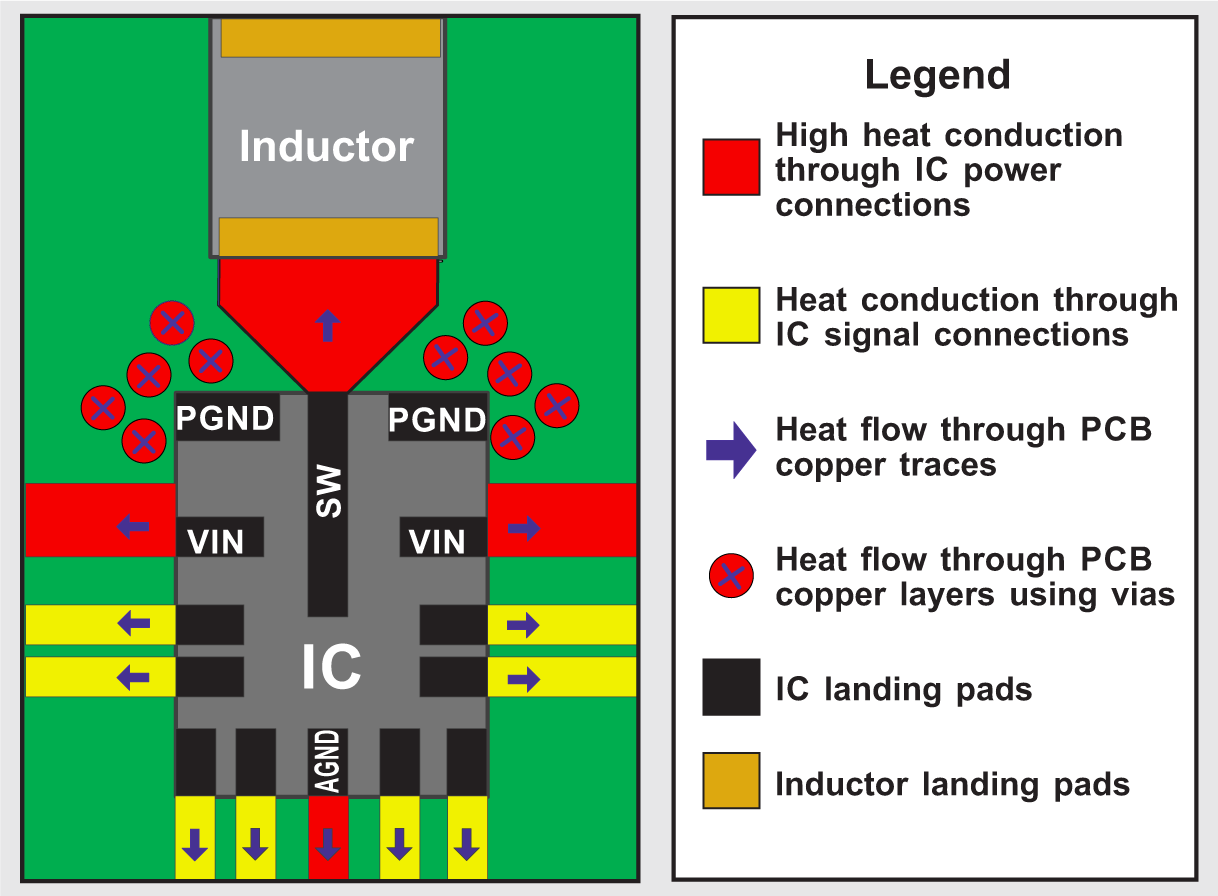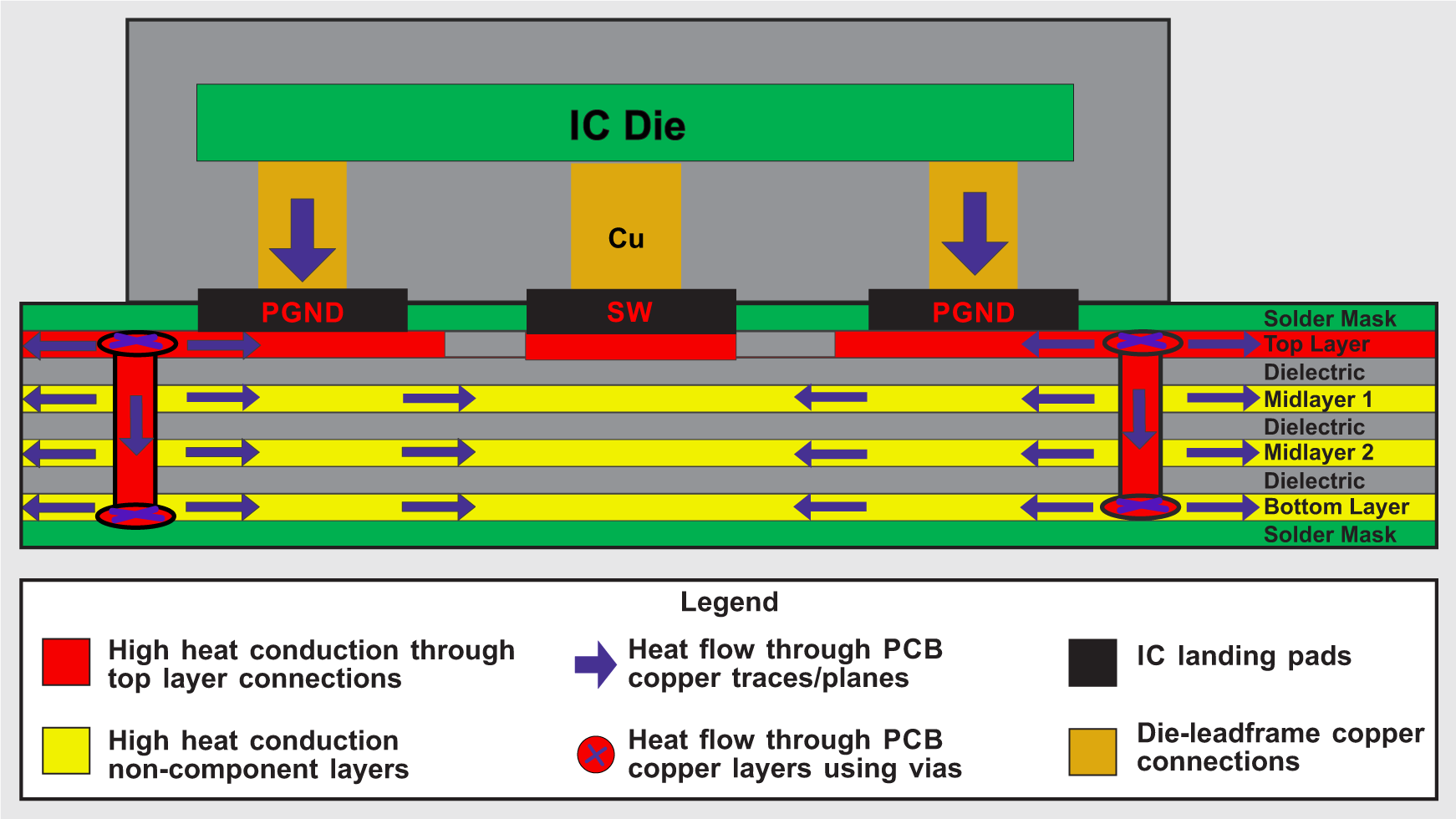-
Thermal design concerns for buck converters in high-power automotive applications
- 1
- 1 Introduction
- 2 Managing Thermals with Flip-chip Packages
- 3 Board Construction Influence
- 4 Copper Area and Thermals
- 5 Estimating a Converter’s Junction Temperature
- 6 Challenges with Measuring Converter Junction Temperature
- 7 Further Thermal Optimization at the IC Level
- 8 Conclusion
- 9 References
- 10Related Web Sites
- IMPORTANT NOTICE
Thermal design concerns for buck converters in high-power automotive applications
1 Introduction
Automotive designs increasingly require higher-performance electronic components with reduced printed circuit board (PCB) cost. This trend has resulted in an uptick in signal-processing operating speeds (and density) on a single board. The increase in operating speeds has in turn raised demand for more compact power supplies to provide room for component routing. While high-performance, high-density power supplies save PCB space, they also generate heat and reduce the heat-dissipation capabilities of surrounding mounted devices, which drives the need for lower-loss power converters that enable a higher thermal margin of neighboring devices.
In recent years, improvements in semiconductor design and layout have enabled the development of more efficient converters that support higher-power applications. Greater converter efficiency also enabled faster switching frequencies, which in turn allowed design engineers to shrink the power-supply solution size and decrease cost by reducing component size and count.
Improved converter control schemes have further reduced passive component counts (Figure 1) without impacting noise or transient performance, and freed up room around the converter for routing devices or to allow for thermal management improvements.
USB Type-C™ is an automotive use case where 2-MHz converter operation allows for extra room in the board layers for additional charging diagnostics. Improved converter efficiency means less heat generation, making it possible to house the power solution in a plastic enclosure that has little airflow. Furthermore, an increase in the integrated circuit’s (IC) maximum operating temperature to 150°C (or above) furthers converter capabilities in applications requiring 105°C or higher ambient temperature ratings.
2 Managing Thermals with Flip-chip Packages
No matter how efficient a buck converter is, losses will occur in the power stage. Power converter losses cause the device junction temperature to rise and prevent safe operation at higher ambient temperatures. Converter design for high ambient temperatures requires proper thermal management to ensure that the converter’s recommended maximum rated junction temperature is not exceeded, and to prevent the converter from heating up neighboring devices.
 Figure 1 Reduced Solution Area with the
LM61440-Q1 Buck Converter
Figure 1 Reduced Solution Area with the
LM61440-Q1 Buck ConverterMany semiconductor manufacturers are implementing converters in a flip-chip package design. A flip-chip device often has a quad flat no-lead (QFN) package, with low-inductance connections made from the semiconductor die to the leadframe. This strikes a good balance between thermal and noise performance. However, the package may lack a thermal pad on its bottom side, which reduces its thermal effectiveness. Nevertheless, with flip-chip devices, efficient heat conduction can occur through the die-to-leadframe copper connections (Figure 2 and Figure 3).
To avoid excessive temperature rise, it makes sense to provide a high thermal conductivity path from the landing pad away from the device. Wide traces to the device landing pads can allow for heat dissipation in the component layer. Dense PCB layouts prevent effective heat dissipation in the component layer, especially with inefficient (hot) neighboring devices. As shown in Figure 3, heat sinking in the inner layers is often more effective than heat dissipation in the component layers. Connecting thermal vias to copper that is connected to the device power or return pins will achieve heat sinking. These vias will then connect to copper planes underneath the IC, increasing the effective copper area for heat sinking. It’s important to place the vias in a way that minimizes thermal bottlenecks, while providing the highest via count with the lowest thermal resistivity to power pins (Figure 2).
 Figure 2 Top View of Flip-chip
Die-to-package Heat-conduction Path for PCB Layer Heat Sinking
Figure 2 Top View of Flip-chip
Die-to-package Heat-conduction Path for PCB Layer Heat Sinking Figure 3 Board Layer View of Flip-chip
Die-to-package Heat-conduction Paths
Figure 3 Board Layer View of Flip-chip
Die-to-package Heat-conduction Paths